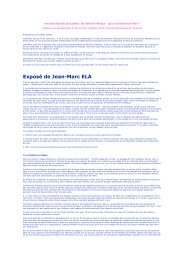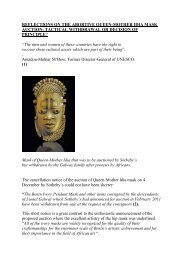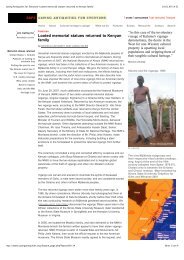ILE.IFE.TRIUMPHS IN BRITISH MUSEUM - Afrikanet.info
ILE.IFE.TRIUMPHS IN BRITISH MUSEUM - Afrikanet.info
ILE.IFE.TRIUMPHS IN BRITISH MUSEUM - Afrikanet.info
Create successful ePaper yourself
Turn your PDF publications into a flip-book with our unique Google optimized e-Paper software.
have the museums been doing in all the hundreds of years they have been<br />
keeping African art The museums have argued against restitution on the ground<br />
that more people see African art in their “great” museums than in Nigeria,<br />
Ghana, Egypt, Ethiopia etc. but it turns out that most of their people know very<br />
little about African art. Museums in Berlin, Frankfurt, London, New York, Paris<br />
and other Western cities have Ife and other African art but even critics and<br />
journalists admit lack of familiarity with Ife art. The exhibition shows an article<br />
in1948 in the Illustrated London News with headlines such as “African art<br />
worthy to rank with the finest works of Italy and Greece” and “Donatellos of<br />
Medieval Africa”. Many of those reviewing the current exhibition - Kingdom of<br />
Ife; Sculptures from West Africa” have been saying more or less the same things.<br />
Has nothing happened to improve the knowledge of Westerners about African<br />
art in the last sixty years What about the works of Ekpo Eyo, Frank Willet,<br />
Leo Frobenius and others What about all those Ife artefacts that Frobenius<br />
brought to Europe and sold to museums and private collectors to finance his<br />
travels Has the important contribution of African art to modernism via the<br />
cubists and the expressionists not helped to make African art more familiar to<br />
Europeans Why must African art and culture remain forever an unknown factor<br />
to Westerners although they have looted and stored in their museums some of<br />
the best art ever produced on our continent Or will this habit of declaring lack<br />
of familiarity with African culture as a way of introduction to general<br />
pronouncements only end when the Western museums have got all our artefacts<br />
locked in their museums A well-known museum director of a famous museum<br />
in New York has argued that since his museum did not possess Nok terracotta<br />
sculptures, he could not recognize one that was depicted in a photo in an article.<br />
His museum possessed thousands of African sculptures but he had been unable<br />
to obtain Nok terracotta from Nigeria. The implication of his argument was that<br />
only African artefacts in Western museums can be known by the general public<br />
and apparently recognized by the museum directors.<br />
Leo Frobenius encountered or, to follow Western terminology, “discovered“ Ife<br />
art in 1910. He attributed the works he saw to some lost Greek tribe since he<br />
could hardly believe that those were the works of Africans. Wole Soyinka, in his<br />
1986 Nobel Lecture, criticized Frobenius for his schizophrenic view of Yoruba<br />
art and the Yoruba. Frobenius was overwhelmed by the beauty of Ife art:<br />
"Before us stood a head of marvellous beauty, wonderfully cast in antique<br />
bronze, true to the life, incrusted with a patina of glorious dark green. This was,<br />
in very deed, the Olokun, Atlantic Africa's Poseidon."<br />
But the same Frobenius also expressed contempt for the people he met at Ife:<br />
"I was moved to silent melancholy at the thought that this assembly of<br />
degenerate and feeble-minded posterity should be the legitimate guardians of so<br />
much loveliness.” (8) Ekpo Eyo, leading authority on Ife and Nigerian art,<br />
writes that Frobenius was astonished by the quality of Ife sculptures and<br />
observed that they were “eloquent of symmetry, vitality, a delicacy of form<br />
6














